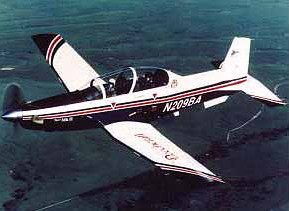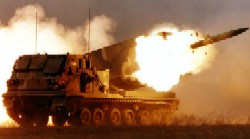Page 1
Daily News
By Gail Helmer
| Send Us News | Archives | Main |
Thursday December 06, 2001
PC News
- Destroyer Command Release Bumped
- Fighting Steel V5.5 Released
- Canadian Auditor General Slams Combat Equipment Readiness
- USAF Approves Production For T-6A Texan II
- Egypt Buys MLRS Rockets
- Boeing Military Post-JSF Environment
- Jane's News Briefs
Destroyer Command Release Bumped
Ubi Soft has pushed back the release date of Destroyer Command to late January 2002. Players take command of Naval Destroyers, patrolling the Atlantic or Pacific Theaters. Destroyer Commmand is based on historical missions from WWII, stalk U-boats, swat Kamikaze planes, escort convoys, blast enemy ships, or pound the beaches in support of infantry landings. Destroyer Command was originally slated to ship simultaneously with Silent Hunter II, which was released November 7, 2001. Destroyer Command and Silent Hunter II include a interoperability feature, making them the first 2 separate games to play against each other via the internet.
Fighting Steel V5.5 Released
Naval Warfare Simulations has announced the release Fighting Steel V5.5. This latest release provides several updates including enhanced realistic night combat. Click here for details.
Military News
Canadian Auditor General Slams Combat Equipment Readiness
In a Report to the Canadian Parliament, Auditor General Sheila Fraser said that the Canadian Forces (CF) faced obstacles in their efforts to manage the readiness of major combat equipment.
The main criticisms were that the CF lacked basic information about the condition of equipment; there was a shortage of qualified maintenance personnel to staff fully operational units and maintenance depots; and had difficulty delivering spare parts for urgent repairs.
"The Department has frequently said that the Canadian Forces have never been more capable," said Sheila Fraser. "But until steps are taken to manage equipment readiness more adequately, these claims should be taken with a grain of salt."
The Auditor General's Report presents the first public information on the state of the ships, aircraft, and land combat vehicles of the Canadian Forces. Among the specific findings were the following:
"National Defence needs to move from talking about performance management to putting systems on the ground and making sure they work," said Ms. Fraser.
- The Air Force: flying time has declined, important equipment is often unavailable, and the Hercules transport and Aurora maritime patrol aircraft fleets are deteriorating.
- The Navy has been able to maintain the number of days at sea, but appears to be falling behind in the maintenance of its frigates.
- The Army, on the other hand, has increased the use of its wheeled combat vehicles, while meeting most maintenance targets.
- The Auditor General urges the Department to take immediate steps to start managing maintenance performance.
The report noted there was a conscious decision to decrease equipment readiness because of budget constraints and because the post-Cold War international situation no longer warranted high levels of readiness. Defence officials had said that these reductions were being carefully controlled. However, the Auditor General said careful control and good planning could only occur with better information about equipment readiness.
Art Eggleton, Canadian Minister of National Defense, responded to the findings by saying, "We recognise that the Forces are facing certain challenges - and we have been moving to address them in a responsible manner. Furthermore, we have been open and transparent about these matters, and have acknowledged them in published reports such as the National Defense Performance Report."
The Department recognised that there were challenges related to information management systems, shortages of qualified people to support equipment, and some Air Force equipment. However, the Minister said that the DND was addressing these challenges "...with initiatives that include the Material Acquisition and Support Information System (MASIS), the Canadian Forces Supply System Upgrade (CFSSU) project, vigorous recruiting and retention efforts, and equipment upgrades such as the modernisation of our CF-18 and Aurora aircraft fleets, and Hercules upgrades."
USAF Approves Production For T-6A Texan II
The US Air Force has issued an Acquisition Decision Memorandum that approves full-rate production for Raytheon Aircraft's T-6A Texan II primary trainer. Darlene Druyun, Air Force principal deputy assistant secretary for acquisition and management, signed an the Memorandum on 3 Dec, authorising the service to procure additional T-6A Texan II aircraft and related systems, besides the 168 aircraft already ordered from prime contractor Raytheon Aircraft Co., in Wichita, Kan. The action also permits the award later this month of the follow-on contract, valued at $1.4 billion, including options.
The decision, known as Milestone III, is a confirmation that the T-6A meets all US Air Force and US Navy requirements, and that the programme is ensured a long-term future. The services are expected to purchase nearly 800 of the aircraft through the year 2017.
"We expected this decision and are pleased that the USAF recognises the safety and capability of the T-6A. The T-6A is ideally suited for its mission to train new pilots. The T-6A met all USAF/USN operational key performance parameters," said David Riemer, vice president - Government Business for Raytheon Aircraft.
The T-6A training system became operational at Moody AFB with the class of student pilots in November 2001. In addition the T-6A has won two major international competitions. The NATO Flying Training in Canada (NFTC) programme flies 24 T-6As and has been training student pilots for a year, and the Hellenic Air Force of Greece started student pilot training in September 2001 with delivery of 17 of the 45 aircraft ordered.
Raytheon Aircraft also developed a comprehensive Ground Based Training System (GBTS) that provides an integrated package of courseware, syllabi, academic training and computerised data management. The GBTS is completely integrated with the air vehicle to provide a total training system through three major areas: curriculum, aircrew training devices (Tads) and the training integration management system (TIMS).
Egypt Buys MLRS Rockets
Lockheed Martin Missiles and Fire Control has received a $72.2 million not-to-exceed contract from the US government for more than 400 Extended-Range Multiple Launch Rocket System (MLRS) rocket pods for Egypt. This foreign military sales (FMS) contract represents the first sale of MLRS to Egypt.
This initial purchase of MLRS rockets by Egypt will be followed by a contract for MLRS launcher and ancillary training and support equipment.
The US Congress approved the FMS sale earlier this year. Delivery of the rocket pods (six MLRS rockets per pod) will begin in the fall of 2002 and be complete by the fall of 2003.
In addition to the US Army and Army National Guard, MLRS launchers and rockets are now in the inventories of (or have been ordered by) Egypt, France, Germany, the United Kingdom, Italy, the Netherlands, Israel, Bahrain, Japan, Norway, Denmark, Turkey, Greece and South Korea.
A single MLRS launcher can put more than two tons of destructive firepower on a target in less than one minute, and its full load of 12 rockets can cover 30 to 60 acres with thousands of grenade-like submunitions. Each of the submunitions in an MLRS rocket has about the same destructive power as a hand grenade and contains a shaped charge that allows it to penetrate light armour. MLRS also fires the Army Tactical Missile System (ATACMS) family of missiles.
The ER MLRS rocket can strike targets up to 28 miles (45 kilometres) away. To achieve the additional range, the existing MLRS warhead was shortened and the rocket motor stretched. Because it uses fewer submunitions, the ER rocket is lighter at burnout than the current version.
Boeing Military Post-JSF Environment
Although it lost the recent and highly publicized "winner take all" Joint Strike Fighter (JSF) competition to Lockheed Martin, arguably the most lucrative military award in memory, aerospace giant Boeing remains very well positioned to meet a growing number of worldwide military aircraft requirements.
"The Chicago-based manufacturer's 737 airliner is generating a good deal of worldwide interest as a maritime patrol and electronic warfare platform," said Forecast International senior aviation analyst Bill Dane, "and we have heard reports that a modified variant of the small Boeing twin may have the inside track to fill the US Navy's upcoming Multirole Maritime Aircraft (MMA) requirement."
Dane added that the MMA would ultimately replace about 225 U.S.-operated P-3C Orions in the maritime patrol and anti-submarine warfare (ASW) missions.
The U.S. Air Force is looking at a plan to lease up to 100 Boeing 767 widebody airliners, at about $20 million per aircraft, for a ten-year period. Suitably modified, these could replace 135 of the service's KC-135E model tankers, which were based on the 707 airframe and are powered by vintage JT3D turbojet engines. Ultimately, the Air Force will also have to replace some 400 KC-135Rs, which have been re-engined with the more efficient CFM56 engines. Realistically, however, the KC-135Rs are unlikely to be replaced much before 2020.
The 767 is attracting a good deal of attention as a tanker/transport on the world market. Whether new production or conversions of ex-airline aircraft, the Boeing widebody is competing for a United Kingdom requirement (18-30 units), with Japan and Canada also showing strong interest. Italy has ordered four 767 tanker/transports and holds options on two more.
The 767 is seen by many as the ultimate successor to the 707 as the E-3 Airborne Warning and Control System (AWACS) platform; four 767 AWACS have already been purchased by the Japanese while USAF and NATO operate 32 and 17 707 AWACS, respectively. In addition, the UK operates seven E-3s, France deploys four, while Saudi Arabia numbers five (plus eight tanker variants) in its air force. The 767 is also being looked at very favorably to replace the E-8 Joint Surveillance Target Attack Radar System (JSTARS) platform, which is based on the venerable 707. USAF has sought funds for 16 JSTARS platforms, eight of which are now in service, and the NATO member nations may also acquire a number of these.
Increasing reports of Taiwan's interest in ordering 60-100 AV-8B Harrier II Plus STOVL fighter aircraft also bode well for Boeing. The manufacturer will deliver the last of 74 AV-8Bs remanufactured to the Harrier II Plus standard in 2003, the same year in which it will wrap up work on five remanufactured Harrier II Plus aircraft for the Spanish Navy.
To avoid paying for a costly re-start of the AV-8B line, Taiwan would have to place an order in the very near future. It is likely that any deal with Taiwan would involve some airframe work being carried out by that country's Aero Industry Development Center (AIDC). A Taiwanese order could prolong the line, providing a window for additional international sales.
Finally, Boeing's F/A-18E/F line is being geared up for USN/USMC requirements calling for some 550 aircraft, and these could be worth in excess of $20 billion, a figure which would rise should any overseas customers order the aircraft. Boeing is also looking at an electronic warfare (EW) variant of the Super Hornet which could replace about 125 EA-6B Prowlers currently serving in that role. Boeing's military aircraft business may thus receive a significant boost by late decade, helping to offset losses in the company's commercial business as a result of events which came to an ugly head on September 11.
| Send Us News | Archives | Main |

